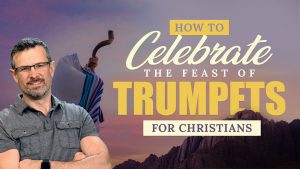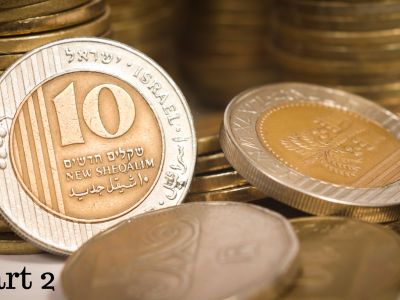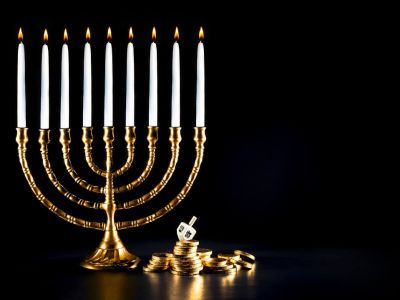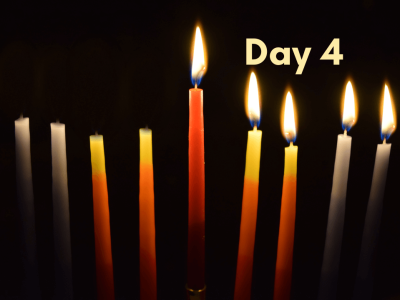How to Celebrate Feast of Trumpets
How to Celebrate Feast of Trumpets
How To Celebrate the Feast of Trumpets for Christians
 Did you know the Feast of Trumpets—Rosh Hashanah—is all about Christ and His Second Coming? That’s right. While many Christians wonder how to celebrate these biblical holidays from a Christian perspective, the truth is, these are not “Jewish” feasts at all. They are God’s feasts, His calendar, designed for His people to walk in rhythm with Him. Today, I’ll show you how to celebrate the Feast of Trumpets in a way that brings meaning to your life and family.
Did you know the Feast of Trumpets—Rosh Hashanah—is all about Christ and His Second Coming? That’s right. While many Christians wonder how to celebrate these biblical holidays from a Christian perspective, the truth is, these are not “Jewish” feasts at all. They are God’s feasts, His calendar, designed for His people to walk in rhythm with Him. Today, I’ll show you how to celebrate the Feast of Trumpets in a way that brings meaning to your life and family.
The Biblical Foundation
In Leviticus 23, God lays out His appointed times. He calls them “My feasts”, not “Jewish feasts.” When He gave these instructions, the Jewish nation as we know it didn’t even exist. Instead, these were given to all Israel at Mount Sinai—and by extension, to anyone who desires to be part of His covenant people.
The Feast of Trumpets, or Yom Teruah, is a high Sabbath. It’s a day of rest, a holy convocation, which means gathering with others when possible. If you don’t have a congregation nearby, gather with family, invite friends, or worship on your own. You can start by reading Leviticus 23:23–25 and Numbers 29:1–6.
Themes of the Feast
The Feast of Trumpets carries several rich themes:
- Kingship: In ancient Israel, kings were inaugurated on this day. Likewise, this feast points to the moment Yeshua (Jesus) will be crowned King of Kings.
- Remembrance: God remembers His covenant, and we remember Him as King and Bridegroom.
- Repentance: The month of Elul (leading into the feast) is a season of repentance, culminating in the Ten Days of Awe before Yom Kippur.
- Awakening: The blowing of the shofar serves as a spiritual wake-up call, reminding us that “the dead in Christ will rise” at the sound of the trumpet (1 Thessalonians 4:16; 1 Corinthians 15:52).
How to Celebrate
Here are practical ways to bring the meaning of this feast into your home:
1. Blowing the Shofar
Gather your family and take turns blowing the ram’s horn. Even imperfect blasts remind us that our voices matter and are meant to proclaim God’s kingship.
2. Worship and Scripture Reading
Sing songs of kingship and worship Yeshua as King. Read Psalms 47, 93–99, or prophetic passages like Isaiah 27:13 and Joel 2. In the New Testament, read Matthew 24:31, 1 Corinthians 15:51–52, and Revelation 11:15.
3. Lighting Candles
As with Sabbath, light two candles—one representing Yeshua, the Light of the World, and the other representing us, reflecting His light.
4. Festive Meal
Enjoy symbolic foods:
- Round challah bread – representing eternity and the cycle of life.
- Apples dipped in honey – symbolizing sweetness and blessing for the coming year.
- Pomegranates – traditionally said to contain 613 seeds, symbolizing God’s commandments.
- Honey cakes and fruits – reinforcing the theme of a sweet year.
5. Blessing Your Family
Take time to lay hands on your children or spouse and speak blessings over their lives for the coming year.
6. Tashlikh (Casting Off)
Write down sins or struggles on paper, then symbolically cast them into a river or bowl of water, representing release and cleansing by God’s Word.
7. Charity and Acts of Kindness
Engage in tzedakah (charity) and teshuvah (repentance). Volunteer, forgive others, or extend kindness in tangible ways.
8. Wearing White
Traditionally, worshippers wear white to symbolize purity, renewal, and the coronation of the King—anticipating the new robes believers will receive at Messiah’s return (Revelation 3:4–5).
Suggested Order of Service
- Call to Worship – open with psalms and songs.
- Candle Lighting – symbolizing the Light of Messiah.
- Shofar Blasts – awakening and proclaiming kingship.
- Scripture Readings – Old and New Testament passages on kingship, remembrance, and the trumpet.
- Teaching or Devotional – on themes of repentance and return.
- Tashlikh Ceremony – casting off sins.
- Prayer and Intercession – for family, community, and nations.
- Festive Meal – apples, honey, round challah, and more.
- Blessing and Closing – end with Psalm 27 and the Aaronic blessing.
Ideas for Families and Kids
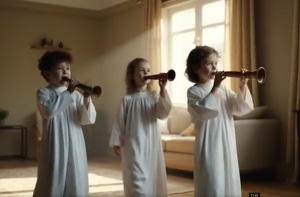 Shofar Parade – let kids march with toy or paper shofars.
Shofar Parade – let kids march with toy or paper shofars.- Apple and Honey Tasting – compare different apple varieties.
- Crafts – crowns for the King, paper shofars, or banners with Hebrew words like Teruah or Melech (King).
- Kindness Jar – write acts of kindness on slips of paper to practice throughout the week.
Singles, seniors, or anyone celebrating alone can also light candles, read scriptures, pray, and even take a prayer walk to a river for Tashlikh.
The Three Returns
The Feast of Trumpets also reminds us of three essential returns:
- Return to God – through prayer and repentance.
- Return to People – through forgiveness and reconciliation.
- Return to Purpose – recommitting to glorify God in your life and serving others.
Why It Matters
For nearly 1,800 years, much of the church lost touch with God’s biblical calendar, replacing it with manmade traditions. But when we return to God’s rhythm—not out of legalism but out of love—we align with His heart. Celebrating His feasts draws us closer to Him, fills our homes with peace and joy, and opens the door to blessings we could never imagine.
The Feast of Trumpets points us forward to the ultimate day when the trumpet will sound, the dead in Christ will rise, and Yeshua will be crowned as King. Until then, let’s celebrate in faith, obedience, and expectation—walking in step with our Bridegroom.
Watch full teaching here:
https://youtu.be/foNvL7_Vicc
Download full transcript:



